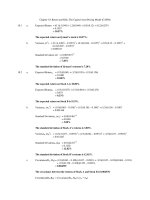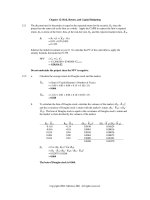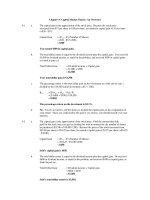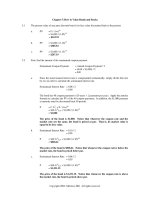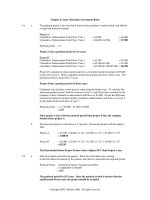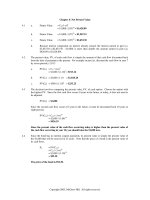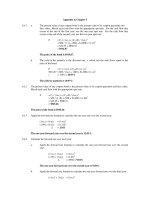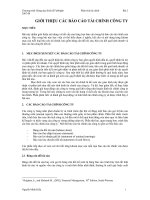Tài liệu Tài chính doanh nghiệp ( Bài tập)_ Chapter 9 pdf
Bạn đang xem bản rút gọn của tài liệu. Xem và tải ngay bản đầy đủ của tài liệu tại đây (154.97 KB, 14 trang )
Chapter 9: Capital Market Theory: An Overview
9.1 a. The capital gain is the appreciation of the stock price. Because the stock price
increased from $37 per share to $38 per share, you earned a capital gain of $1 per share
(=$38 - $37).
Capital Gain = (P
t+1
– P
t
) (Number of Shares)
= ($38 - $37) (500)
= $500
You earned $500 in capital gains.
b. The total dollar return is equal to the dividend income plus the capital gain. You received
$1,000 in dividend income, as stated in the problem, and received $500 in capital gains,
as found in part (a).
Total Dollar Gain = Dividend income + Capital gain
= $1,000 + $500
= $1,500
Your total dollar gain is $1,500.
c. The percentage return is the total dollar gain on the investment as of the end of year 1
divided by the $18,500 initial investment (=$37 × 500).
R
t+1
= [Div
t+1
+ (P
t+1
– P
t
)] / P
t
= [$1,000 + $500] / $18,500
= 0.0811
The percentage return on the investment is 8.11%.
d. No. You do not need to sell the shares to include the capital gains in the computation of
your return. Since you could realize the gain if you choose, you should include it in your
analysis.
9.2 a. The capital gain is the appreciation of the stock price. Find the amount that Seth
paid for the stock one year ago by dividing his total investment by the number of shares
he purchased ($52.00 = $10,400 / 200). Because the price of the stock increased from
$52.00 per share to $54.25 per share, he earned a capital gain of $2.25 per share (=$54.25
- $52.00).
Capital Gain = (P
t+1
– P
t
) (Number of Shares)
= ($54.25 - $52.00) (200)
= $450
Seth’s capital gain is $450.
b. The total dollar return is equal to the dividend income plus the capital gain. He received
$600 in dividend income, as stated in the problem, and received $450 in capital gains, as
found in part (a).
Total Dollar Gain = Dividend income + Capital gain
= $600 + $450
= $1,050
Seth’s total dollar return is $1,050.
c. The percentage return is the total dollar gain on the investment as of the end of year 1
divided by the initial investment of $10,400.
R
t+1
= [Div
t+1
+ (P
t+1
– P
t
)] / P
t
= [$600 + $450] / $10,400
= 0.1010
The percentage return is 10.10%.
e. The dividend yield is equal to the dividend payment divided by the purchase price of the
stock.
Dividend Yield = Div
1
/ P
t
= $600 / $10,400
= 0.0577
The stock’s dividend yield is 5.77%.
9.3 Apply the percentage return formula. Note that the stock price declined during the period. Since
the stock price decline was greater than the dividend, your return was negative.
R
t+1
= [Div
t+1
+ (P
t+1
– P
t
)] / P
t
= [$2.40 + ($31 - $42)] / $42
= -0.2048
The percentage return is –20.48%.
9.4 Apply the holding period return formula. The expected holding period return is equal to the total
dollar return on the stock divided by the initial investment.
R
t+2
= [P
t+2
– P
t
] / P
t
= [$54.75 - $52] / $52
= 0.0529
The expected holding period return is 5.29%.
9.5 Use the nominal returns, R, on each of the securities and the inflation rate, π, of 3.1% to calculate
the real return, r.
r = [(1 + R) / (1 + π)] – 1
a. The nominal return on large-company stocks is 12.2%. Apply the formula for the real
return, r.
r = [(1 + R) / (1 + π)] – 1
= [(1 + 0.122) / (1 + 0.031)] – 1
= 0.0883
The real return on large-company stocks is 8.83%.
b. The nominal return on long-term corporate bonds is 6.2%. Apply the formula for the real
return, r.
r = [(1 + R) / (1 + π)] – 1
= [(1 + 0.062) / (1 + 0.031)] – 1
= 0.03
The real return on long-term corporate bonds is 3.0%.
c. The nominal return on long-term government bonds is 5.8%. Apply the formula for the
real return, r.
r = [(1 + R) / (1 + π)] – 1
= [(1 + 0.058) / (1 + 0.031)] – 1
= 0.0262
The real return on long-term government bonds is 2.62%.
d. The nominal return on U.S. Treasury bills is 3.8%. Apply the formula for the real return,
r.
r = [(1 + R) / (1 + π)] – 1
= [(1 + 0.038) / (1 + 0.031)] – 1
= 0.00679
The real return on U.S. Treasury bills is 0.679%.
9.6 The difference between risky returns on common stocks and risk-free returns on Treasury bills is
called the risk premium. The average risk premium was 8.4 percent (= 0.122 – 0.038) over the
period. The expected return on common stocks can be estimated as the current return on Treasury
bills, 2 percent, plus the average risk premium, 8.4 percent.
Risk Premium = Average common stock return – Average Treasury bill return
= 0.122 – 0.038
= 0.084
E(R) = Treasury bill return + Average risk premium
= 0.02 + 0.084
= 0.104
The expected return on common stocks is 10.4 percent.
9.7 Below is a diagram that depicts the stocks’ price movements. Two years ago, each stock had the
same price, P
0
. Over the first year, General Materials’ stock price increased by 10 percent, or
(1.1) × P
0
. Standard Fixtures’ stock price declined by 10 percent, or (0.9) × P
0
. Over the second
year, General Materials’ stock price decreased by 10 percent, or (0.9) (1.1) × P
0
, while Standard
Fixtures’ stock price increased by 10 percent, or (1.1) (0.9) × P
0
. Today, each of the stocks is
worth 99% of its original value.
2 years ago 1 year ago Today
General Materials P
0
(1.1) P
0
(1.1) (0.9) P
0
= (0.99) P
0
Standard Fixtures P
0
(0.9) P
0
(0.9) (1.1) P
0
= (0.99) P
0
9.8 Apply the five-year holding-period return formula to calculate the total return on the S&P 500
over the five-year period.
Five-year holding-period return = (1 +R
1
) × (1 +R
2
) × (1 +R
3
) × (1 +R
4
) × (1 +R
5
) – 1
= (1 + -0.0491) × (1 + 0.2141) × (1 + 0.2251) ×
(1 + 0.0627) × (1 + 0.3216) – 1
= 0.9864
The five-year holding-period return is 98.64 percent.
9.9 The historical risk premium is the difference between the average annual return on long-term
corporate bonds and the average risk-free rate on Treasury bills. The average risk premium is 2.4
percent (= 0.062 – 0.038).
Risk Premium = Average corporate bond return – Average Treasury bill return
= 0.062 – 0.038
= 0.024
The expected return on long-term corporate bonds is equal to the current return on Treasury bills,
2 percent, plus the average risk premium, 2.4 percent.
E(R) = Treasury bill return + Average risk premium
= 0.02 + 0.024
= 0.044
The expected return on long-term corporate bonds is 4.4%.
9.10 a. To calculate the expected return, multiply the return for each of the three scenarios by the
respective probability of occurrence.
E(R
M
) = R
Recession
× Prob(Recession)+ R
Normal
× Prob(Normal) + R
Boom
× Prob(Boom)
= -0.082 × 0.25 + 0.123 × 0.50 + 0.258 × 0.25
= 0.1055
The expected return on the market is 10.55 percent.
E(R
T
) = R
Recession
× Prob(Recession)+ R
Normal
× Prob(Normal) + R
Boom
× Prob(Boom)
= 0.035 × 0.25 + 0.035 × 0.50 + 0.035 × 0.25
= 0.035
The expected return on Treasury bills is 3.5 percent.
b. The expected risk premium is the difference between the expected market return and the
expected risk-free return.
Risk Premium = E(R
M
) – E(R
T
)
= 0.1055 – 0.035
= 0.0705
The expected risk premium is 7.05 percent.
9.11 a. Divide the sum of the returns by seven to calculate the average return over the seven-year
period.
R
= (R
t-7
+ R
t-6
+ R
t-5
+ R
t-4
+ R
t-3
+ R
t-2
+ R
t-1
) / (7)
= (-0.026 + -0.01 + 0.438 + 0.047 + 0.164 + 0.301 + 0.199) / (7)
= 0.159
The average return is 15.9 percent.
b. The variance, σ
2
, of the portfolio is equal to the sum of the squared differences between
each return and the mean return [(R -
R
)
2
], divided by six.
R
R -
R
(R -
R
)
2
-0.026 -0.185 0.03423
-0.01 -0.169 0.02856
0.438 0.279 0.07784
0.047 -0.112 0.01254
0.164 0.005 0.00003
0.301 0.142 0.02016
0.199 0.040 0.00160
Total 0.17496
Because the data are historical, the appropriate denominator in the calculation of the
variance is six (=T – 1).
σ
2
= [Σ(R -
R
)
2
] / (T – 1)
= 0.17496 / (7 – 1)
= 0.02916
The variance of the portfolio is 0.02916.
The standard deviation is equal to the square root of the variance.
σ = (σ
2
)
1/2
= (0.02916)
1/2
= 0.1708
The standard deviation of the portfolio is 0.1708.
9.12 a. Calculate the difference between the return on common stocks and the return on Treasury
bills.
Year
Common
Stocks
Treasury
Bills
Realized
Risk Premium
-7 32.4% 11.2%
21.2%
-6 -4.9 14.7
-19.6
-5 21.4 10.5
10.9
-4 22.5 8.8
13.7
-3 6.3 9.9
-3.6
-2 32.2 7.7
24.5
Last 18.5 6.2
12.3
b. The average realized risk premium is the sum of the premium of each of the seven years,
divided by seven.
Average Risk Premium = (0.212 + -0.196 + 0.109 + .137 + -0.036 + 0.245 + 0.123) / 7
= 0.0849
The average risk premium is 8.49 percent.
c. Yes. It is possible for the observed risk premium to be negative. This can happen in any
single year, as it did in years -6 and -3. The average risk premium over many years is
likely positive.
